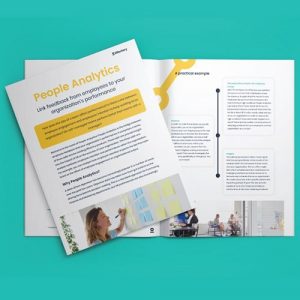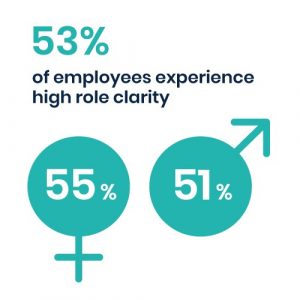Choose the proper analytical tools to gain meaningful insights that will guide your HR strategies and unlock your employees’ full potential.
The right HR Analytics solution for your business

People analytics focuses on a company’s most important assets, human capital, to improve business outcomes. Gathering and analyzing employee data empowers organizations to identify employee experience, engagement, and performance patterns. Businesses then use this data-driven approach and what they learn from it to avoid wasting resources, to clear roadblocks for their teams, and to address inefficiencies.
HR analytics gives organizations the insight they need to create work environments where employees are set up to succeed. However, building an in-house HR analytics strategy from the ground up is time-consuming and costly, and you need experience in people analytics to be successful. Thankfully, various HR analytics solutions have been designed to relieve the burden, streamline strategy development and deployment, and deliver a worthwhile return on investment.
This article will explore the role and benefits of people analytics, outline the key considerations to selecting the right tools for maximum impact, and explain how to implement HR analytics solutions.
Create impact with People Analytics
Link feedback from employees to your organization’s performance
DownloadWhy HR analytics matters
HR initiatives are often dismissed as worthless investments whose outcomes are too difficult to track or quantify. With the proper tools, however, HR analytics can deliver quantifiable results that significantly boost an organization’s bottom line. In one quick service restaurant chain, a people analytics solution reduced attrition, increased customer satisfaction scores by 100 percent, and increased sales by 5 percent.
The instincts and intuition of company leaders have historically guided the process of hiring and managing talent. While a team leader or manager ‘s experience and insight are valuable, deferring to their intuition prioritizes style over substance and makes decisions vulnerable to bias in the hiring process. Hiring based on HR analytics data about past hires can significantly reduce the incidence and associated costs of bad hires. This data-driven approach also improves workplace diversity, which McKinsey has found to be closely linked with profitability.
HR analytics can not only help businesses avoid costly mistakes but also improve overall performance and productivity. Numerous HR analysis methods, like capability and capacity analytics, can provide actionable insights for improved business outcomes. Capability analytics focuses on employees’ strengths while also highlighting both potential skill gaps and training opportunities that may necessitate new hires. Capacity analytics looks at how employees use their time and whether inefficient processes and administrative roadblocks are hurting their productivity.
In short, people analytics empowers both HR and the organization as a whole to use their data and gain insight into their teams for better decision-making.

Choosing the right solution for your business
When choosing an analytics solution, HR departments need to ask themselves key questions about their HR software options. Each program has strengths and weaknesses, and some are more suited to specific industries or company structures than others.
The ultimate Guide to define What is People Analytics – Effectory
Ask yourself the following:
What problems are you trying to solve?
HR analytics helps reveal organizational inefficiencies and problem areas. A well-designed people analytics strategy should consistently find opportunities for improvement. When companies identify potential areas for improvement, they can make more informed choices on which HR tools best suit their needs and goals.
HR analytics can improve:
- Hiring practices
- Attendance (especially absenteeism problems)
- Turnover (especially attrition problems)
- Compensation and benefits
- Employee productivity
- Training and employee development plans
- Leadership’s understanding of engagement drivers
- Customer satisfaction
As people analytics becomes a greater priority across industries, companies are applying its approaches to increasingly diverse problems, up to and including the selection of a new office location.
How much data do you have?
HR reports are the foundational source for all analyses. You need data on your employees to identify patterns and form hypotheses as key steps in the analytical process. While over 97 percent of HR departments gather data on their employees, only about 2 percent of teams report being able to collect information, analyze it, and implement solutions based on the findings without running into snags. For example, if an organization wants to identify which employees are attrition risks and to forecast employee behavior using predictive analytics, they will need at least two years’ worth of data to build their predictive model. For more reliable and comprehensive insights, data sets spanning a three to five-year period are preferable.
Organizations with large gaps in their current systems or that have no data whatsoever should prioritize robust data collection and data management tools. Companies that already have sufficient data but need help identifying patterns should look for tools designed to facilitate analysis and generate actionable insights.
People Analytics: 5 Real Case Studies
How large is your business?
In recent years, many of the biggest and most reputable industry leaders have championed HR analytics. The catch is that HR analytics is therefore often mistakenly seen as only applicable to larger organizations. In reality, small businesses can benefit from people analytics in many different ways, especially those working with thin margins.
Because setting up an in-house HR analytics team is costly, small businesses are arguably good candidates for ready-made tools. They will want to make sure the solution they choose is designed to provide insights with limited data. HR solutions for small businesses often focus on making day-to-day HR responsibilities such as payroll easier, but they too can benefit from insights on talent management, hiring, scheduling, and absenteeism.
HR Analytics: Role Clarity infographic & fact sheet
Get data-driven insights about role clarity in the workplace by downloading this infographic and fact sheet.
DownloadHow knowledgeable is your team when it comes to HR analytics?
The human resources field is quickly evolving, and data is becoming an increasingly important part of the equation. People analytics’ data-driven approach is a competitive advantage organizations can no longer afford to overlook.
According to a LinkedIn study, “55 percent of talent professionals say they still need help putting basic people analytics into practice.” Businesses should fill skill gaps in their HR departments if they are able to hire data analysts, while larger organizations may consider putting together a people analytics team. For smaller to medium-sized businesses, adding dedicated HR analytics members to their team might not be financially viable. In that case, finding the tools and solutions best suited to their HR team’s current abilities will be essential. Those tools are also opportunities for them to develop their analytical skills.
Some HR analytics tools are very user-friendly, while others offer more features but have a steeper learning curve. Ideally, HR teams without experience in people analytics should be given onboarding tools and resources that make it easy to get started and, later, refine their approach as they get used to the process.
What is predictive people analytics?
Testing the tools
Every organization is different. To get the most out of your HR analytics strategy, you need to find the solution that best aligns with your HR department’s talent and skills. Remember, like a bad hire, choosing the wrong HR analytics solution can be a costly mistake.
Ian Cook, Director of Product Management at workforce analytics company Visier, recommends starting with a pilot project. Introduce an HR analytics tool or solution to a single team or department for a short period of time, then evaluate the results. According to Cook, “the advantage of the pilot approach is that you can point to real value and justify how much more value can be created through building an appropriately resourced function, rather than asking for the function without any substantive claims on what it can deliver to the organisation.” By testing a specific people analytics tool or solution on a limited scale, the HR department can evaluate that tool’s efficacy, which enables them to build a business case justifying its value and return on investment.
People analytics gives organizations a competitive edge and positions employees to do their best work. Developing an HR analytics strategy can be challenging, but with the right solutions and tools, your HR team can quickly start providing valuable insights and improve business outcomes. People analytics can create positive change in hiring practices, employee development, customer satisfaction, and many more areas, all of which affect a company’s bottom line.
Effectory has improved the performance of some of Europe’s top brands with powerful people analytics tools like surveys to gather data and feedback from employees. Effectory solutions deliver meaningful, actionable results. If your HR department is looking to implement a people analytics solution, connect with one of our consultants to learn more and request a demo.
Book a free demo. See our solutions in action.
Effectory is Europe’s Leading provider of Employee Listening Solutions. Schedule a product demo and discover how to enhance your employees’ engagement.
Demo request

